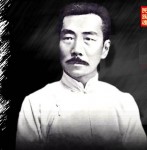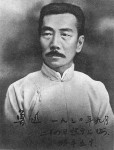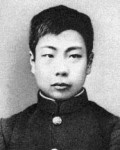Lu Xun (Zhou Shuren)
“For all of ignorant people of a nation, even if their body is somehow strong, somehow grand, even then they can only make meaningless displays [of this “strength”]. [As for] the multitude of constituents and observers, however many may die from [this] sickness, this is [still] not to be considered as unfortunate.”
From the preface of Lu Xun’s work Na Han (Call to Arms)
Note: Lu Xun was a doctor before he became a writer. Once he saw on a film a Chinese being executed by Japanese while many other Chinese were watching this “spectacular event”. This made him felt that saving the “souls” of people is more important than saving their bodies.
Lu Xun, was the pen name of Zhou Shuren (September 25, 1881 – October 19, 1936) is one of the major Chinese writers of the 20th century. Considered by many to be the founder of modern Chinese literature, he wrote in baihua (the vernacular) as well as classical Chinese. Lu Xun was a short story writer, editor, translator, critic, essayist and poet. In the 1930s he became the titular head of the Chinese League of Left-Wing Writers in Shanghai.
19, 1936) is one of the major Chinese writers of the 20th century. Considered by many to be the founder of modern Chinese literature, he wrote in baihua (the vernacular) as well as classical Chinese. Lu Xun was a short story writer, editor, translator, critic, essayist and poet. In the 1930s he became the titular head of the Chinese League of Left-Wing Writers in Shanghai.
Lu Xun’s works exerted a very substantial influence after the May Fourth Movement to such a point that he was lionized by the Communist regime after 1949. Mao Zedong himself was a lifelong admirer of Lu Xun’s works. Though sympathetic to the ideals of the Left, Lu Xun never actually joined the Chinese Communist Party. Lu Xun’s works are known to English readers through numerous translations, especially Selected Stories of Lu Hsun translated by Yang Hsien-yi and Gladys Yang.
Early life
Born in Shaoxing, Zhejiang province, Lu Xun was first named Zhou Zhangshou, then Zhou Yucai, and finally himself took the name of Shùrén, figuratively, “to be an educated man”.
The Shaoxing Zhou family was very well-educated, and his paternal grandfather Zhou Fuqing held posts in the Hanlin Academy; Zhou’s mother, née Lu, taught herself to read. However, after a case of bribery was exposed – in which Zhou Fuqing tried to procure an office for his son, Lu Xun’s father, Zhou Boyi – the family fortunes declined. Zhou Fuqing was arrested and almost beheaded. Meanwhile, a young Zhou Shuren was brought up by an elderly servant Ah Chang, whom he called Chang Ma; one of Lu Xun’s favorite childhood books was the Classic of mountains and seas.
His father’s chronic illness and eventual death during Lu Xun’s adolescence, apparently from tuberculosis, persuaded Zhou to study medicine. Distrusting traditional Chinese medicine (which in his time was often practised by charlatans, and which failed to cure his father), he went abroad to pursue a Western medical degree at Sendai Medical Academy (now medical school of Tohoku University) in Sendai, Japan, in 1904.
Education
Lu Xun was educated at Jiangnan Naval Academy (1898-99), and later transferred to the School of Mines and Railways at Jiangnan Military Academy. It was there Lu Xun had his first contacts with Western learning, especially the sciences; he studied some German and English, reading, amongst some translated books, Huxley’s Evolution and Ethics, J. S. Mill’s On Liberty, as well as novels like Ivanhoe and Uncle Tom’s Cabin.
On a Qing government scholarship, Lu Xun left for Japan in 1902. He first attended the Kobun Gakuin (Kobun Institute) (Hongwen xueyuan), a preparatory language school for Chinese students attending Japanese universities. His earliest essays, written in Classical Chinese, date from here. Lu also practised some jujutsu.
Lu Xun returned home briefly in 1903. Aged 22, he complied to an arranged marriage with a local gentry girl, Zhu An. Zhu, illiterate and with bound feet, was handpicked by her mother. Lu Xun possibly never consummated this marriage, although he took care of her material needs all his life.
Sendai
Lu Xun left for Sendai Medical Academy in 1904 and gained a minor reputation there as the first foreign student of the college. At the school he struck up a close student-mentor relationship with lecturer Fujino Genkurou ; Lu Xun would recall his mentor respectfully and affectionately in an essay “Mr Fujino” in the memoirs in Dawn Blossoms Plucked at Dusk. (Incidentally, Fujino would repay the respect with an obituary essay on his death, in 1937.) However, in March 1906, Lu Xun abruptly terminated his pursuit of the degree and left the college.
Lu Xun, in his well-known Preface to Nahan (Call to Arms), the first collection of his short stories, tells the story of why he gave up completing his medical education at Sendai. Over the counter viagra One day after class, one of his Japanese instructors screened a lantern slide documenting the imminent execution of an alleged Chinese spy during the Russo-Japanese War (1904-05). Lu Xun was shocked by the complete apathy of the Chinese onlookers; he decided it was more important to cure his compatriots’ spiritual ills rather than their physical diseases.
“At the time, I hadn’t seen any of my fellow Chinese in a long time, but one day some of them showed up in a slide. One, with his hands tied behind him, was in the middle of the picture; the others were gathered around him. Physically, they were as strong and healthy as anyone could ask, but their expressions revealed all too clearly that spiritually they were calloused and numb. According to the caption, the Chinese whose hands were bound had been spying on the Japanese military for the Russians. He was about to be decapitated as a ‘public example.’ The other Chinese gathered around him had come to enjoy the spectacle.” (Lyell , pp 23).
Moving to Tokyo in spring 1906, he came under the influence of scholar and philologist Zhang Taiyan and with his brother Zuoren, also on scholarship, published a translation of some East European and Russian Slavic short stories. He spent the next three years in Tokyo writing a series of essays in wenyan (classical Chinese) on the history of science, Chinese and comparative literature, European literature and intellectual history, Chinese society, reform and religion, as well as translating the literature of various countries into Chinese.
Career
Returning to China, Lu Xun began teaching in the Zhejiang Secondary Normal School, the predecessor of famous Hangzhou High School, Shaoxing Chinese-Western School Middle school of Shaojun, the predecessor of Shaoxing No.1 High School) in his hometown. With the establishment of the republic, he briefly held a post in the Ministry of Education at Beijing. Encouraged by some fellow associates, he took up teaching positions at the Peking University and Peking Women’s Teachers College and began to write.
In May 1918, Lu Xun used this pen name for the first time and published the first major baihua short story, Kuangren Riji, “A Madman’s Diary”). He chose the surname Lu as it was his mother’s maiden family name. Partly inspired by the Gogol short story, it was a scathing criticism of outdated Chinese traditions and feudalism which was metaphorically ‘gnawing’ at the Chinese like cannibalism. It immediately established him as one of the most influential writers of his day.
Another of his well-known longer stories, The True Story of Ah Q (A Q Zhengzhuan), was published in installments from 1921 to 1922. The latter would Buy cartia xt become his most famous work. Both works were included in his first short story collection Na Han or Call to Arms, published in 1923.
Between 1924 to 1926, Lu wrote his essays of ironic reminiscences in Zhaohua Xishi (Dawn Dew-light Collected at Dusk), published 1928, as well as the prose poem collection Ye Cao (Wild Grass, published 1927). Lu Xun also wrote many of the stories to be published in his second short story collection Pang Huang (Wandering) in 1926. Becoming increasingly generic lasix estranged with his brother Zuoren, the stories are typically more melancholic than in his earlier collection. Brand levitra From 1926, after the March 18 Massacre, for supporting the students’ protests which led to the incident, he went on an imposed exile to Xiamen, Amoy University, then to Zhongshan University at Guangzhou with his wife Xu Guangping.
From 1927 to his death, Lu Xun shifted to the more liberal city of Shanghai, where he co-founded the Chinese League of Left-Wing Writers.[1] Most of his essays date from this last period. Xu Guangping gave birth to a son, Haiying, on September 27th, 1929. She was in labor with the baby for 27 hours. The child’s name meant simply “Shanghai infant”. His parents chose the name thinking that he could change it himself later, but he never did so.[2] In 1930 Lu Xun’s Zhongguo Xiaoshuo Shilue (A Concise History of Chinese Fiction) was published. It is a comprehensive overview of history of Chinese fiction up till that time, drawn from Lu Xun’s own lectures delivered at Peking University and would become one of the landmark books of Chinese literary criticism in the twentieth-century.
 His other important works include volumes of translations — notably from Russian (he particularly admired Nikolai Gogol and made a translation of Dead Souls, and his own first story’s title is inspired by a work of Gogol) — discursive writings like Re Feng (Hot Wind), and many other works such as prose essays, which number around 20 volumes or more. As a left-wing writer, Lu played an important role in the history of Chinese literature. His books were and remain highly influential and popular even today. Lu Xun’s works also appear in high school textbooks in Japan. He is known to Japanese by the name Rojin (??? Buy Cialis Super Active+ Online in Katakana).
His other important works include volumes of translations — notably from Russian (he particularly admired Nikolai Gogol and made a translation of Dead Souls, and his own first story’s title is inspired by a work of Gogol) — discursive writings like Re Feng (Hot Wind), and many other works such as prose essays, which number around 20 volumes or more. As a left-wing writer, Lu played an important role in the history of Chinese literature. His books were and remain highly influential and popular even today. Lu Xun’s works also appear in high school textbooks in Japan. He is known to Japanese by the name Rojin (??? Buy Cialis Super Active+ Online in Katakana).
Lu Xun was the editor of several left-wing magazines such as New Youth (Xin Qingnian) and Sprouts (Meng Ya). Because of his leanings, and of the role his works played in the subsequent history of the People’s Republic of China, Lu Xun’s works were banned in Taiwan until late 1980s. He was among the early supporters of the Esperanto movement in China.
Last days and death
By 1936, Lu Xun’s lungs had been greatly weakened by tuberculosis. In March of that year, he was stricken with bronchitic asthma and a fever. The treatment for this involved draining 300 grams of fluid in the lungs through puncture. From June to August, he was again sick, and his weight dropped to only 83 pounds. He recovered some, and wrote two essays in the fall reflecting on mortality. These included “Death”, and “This Too Is Life”. At 3:30 AM on the morning of October 18th, the author woke with great difficulty breathing. Dr. Sudo, his physician, was summoned, and Lu Xun took injections to relieve the pain. His wife was with him throughout that night, but Lu Xun was found without a pulse at 5:11 AM the next morning, October 19th.[3] His remains were interred in a mausoleum within Lu Xun Park in Shanghai. He was survived by his son, Haiying.
Legacy
Lu Xun’s importance to modern Chinese literature lies in the fact that he contributed significantly to every modern literary genre except the novel during his lifetime. He wrote in a clear lucid style which was to influence many generations, in stories, prose poems and essays. Lu Xun’s translations were important in a time when Western literature were seldom read, and his literary criticisms remain acute and persuasively argued.
The relationship between Lu Xun and the Communist Party of China after the author’s death was a complex one. On one hand, Party leaders depicted him as “drawing the blueprint of the communist future”. Mao Zedong defined him as the “chief commander of China’s cultural revolution”. At the same time, leaders downplayed the influence of the cosmopolitan May Fourth Movement on Lu Xun, in order to match Lu Xun with the Communist Party’s support of folk literature and the common people. During the 1920s and 1930s, Lu Xun and his contemporaries often met informally for freewheeling intellectual discussions. As the Party sought more control over intellectual life in China, this type of intellectual independence was suppressed. Finally, Lu Xun’s satirical and ironic writing style itself was discouraged. Mao wrote that “…the style of the essay should not simply be like Lu Xun’s. [In a Communist society] we can shout at the top of our voices and have no need for veiled and round-about expressions, which are hard for the people to understand”. Thus, the Communist Party both hailed Lu Xun as one of the fathers of Communism in China and suppressed the intellectual culture and style of writing that he represented. A lot of his essays and writings are part of the primary school and middle school compulsory curriculum in the Communist China.[6]
The work of Lu Xun has also received attention outside of China. In 1986, Fredric Jameson, a prominent American Marxist, cited “A Madman’s Diary” as the “supreme example” of the “national allegory” form that all Third World literature takes.[7] Gloria Davies compares Lu Xun to Nietzsche, saying that both were “trapped in the construction of a modernity which is fundamentally problematic”.[8]
Notes
1) Laurence, Patricia Ondek (2003). Lily Briscoe’s Chinese eyes: Bloomsbury, modernism, and China. University of South Carolina Press. pp. 106. ISBN 1570035059.
2) McDougall, Bonnie S.; Lu Xun, Xu Guangping (2002). Love-letters and Buy Wellbutrin SR Online Pharmacy No Prescription Needed Privacy in Modern China: The Intimate Lives of Lu Xun and Xu Guangping. Oxford University Press. pp. 64.
3) Jenner, W. J. F. (September 1982). “Lu Xun’s Last Days and after”. The China Quarterly (Cambridge University Press on behalf of the School of Oriental and African Studies) 91: 424–445. doi:10.1017/S0305741000000643. Retrieved 2008-07-01.
4) Hesford, Walter (April 1992). “Overt Appropriation”. College English (National Council of Teachers of English) 54 (4): 406–417. doi:10.2307/377832. Retrieved 2008-07-02.
5) Lee, Leo Ou-Fan (July 1976). “Literature on the Eve of Revolution: Reflections on Lu Xun’s Leftist Years, 1927-1936”. Modern China (Sage Publications, Inc.) 2 (3): 277–326. doi:10.1177/009770047600200302. Retrieved 2008-07-02.; Lydia Liu,”Translating National Character: Lu Xun and Arthur Smith,” Ch 2, Translingual Practice: Literature, National Culture, and Translated Modernity: China 1900-1937 (Stanford 1995).
6) Goldman, Merle (September 1982). “The Political Use of Lu Xun”. The China Quarterly (Cambridge University Press on behalf of the School of Oriental and African Studies) 91: 446–447. doi:10.1017/S0305741000000655. Retrieved 2008-07-01.
7) Jameson, Fredric (Autumn, 1986). “Third-World Literature in the Era of Multinational Capitalism”. Social Text (Duke University Press) 15: 65–88. Retrieved 2008-07-02.
8) Davies, Gloria (July 1992). “Chinese Literary Studies and Post-Structuralist Positions: What Next?”. The Australian Journal of Chinese Affairs (Contemporary China Center, Australian National University) 28: 67–86. doi:10.2307/2950055. Retrieved 2008-07-02.
Hi, cool site, just have something to ask you, what antispam software you have on your site for comments because I get lots on my web site.